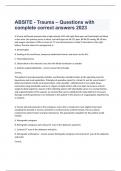Exam (elaborations)
ABSITE - Trauma – Questions with complete correct answers 2023
- Course
- Institution
ABSITE - Trauma – Questions with complete correct answers 2023A 34-year-old female presents after a high-velocity MVC with right flank pain and frank bright red blood in her urine. Her primary survey is intact, and vital signs are HR 112 bpm, BP 86/59 mmHg, RR 20/min, and oxygen saturation is 98%...
[Show more]



